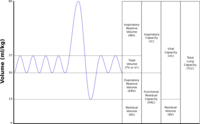
Photo from wikipedia
Purpose To analyze the changes in thrombelastography (TEG) in patients with acute exacerbation of chronic obstructive pulmonary disease (AECOPD) and the relationship with indicators related to lung function. Methods 100… Click to show full abstract
Purpose To analyze the changes in thrombelastography (TEG) in patients with acute exacerbation of chronic obstructive pulmonary disease (AECOPD) and the relationship with indicators related to lung function. Methods 100 patients with AECOPD admitted to our hospital from May 2021 to May 2022 were selected as the AE group, and another 80 patients with a stable phase of COPD in the same period were selected as the SP group. Fresh blood specimens were collected from both groups, and TEG-related indicators (R value, K value, α-angle, MA value) were measured using the TEG technique, and lung function-related indicators (FEV1, FVC, FEV1/FVC, FEV1%) were measured using a lung function meter, and the correlation between TEG-related indicators and lung function-related indicators was analyzed. Results Patients in the AE group had lower R and K values and higher α-angle and MA values than those in the SP group, all with statistically significant differences (P < 0.05). Patients in the AE group had lower FEV1, FVC, FEV1/FVC, and FEV1% levels than those in the SP group, all with statistically significant differences (P < 0.05). Correlation analysis showed that the R value in TEG of AECOPD patients was positively correlated with pulmonary function-related indicators (FEV1, FVC, FEV1/FVC, FEV1%) (r = 0.565, 0.529, 0.447, 0.527, all P < 0.001); K value was positively correlated with pulmonary function-related indicators (FEV1, FVC, FEV1/FVC, FEV1%) (r = 0.512, 0.567, 0.459, 0.439, all P < 0.001); α-angle was inversely correlated with pulmonary function-related indicators (FEV1, FVC, FEV1/FVC, FEV1%) (r = −0.498, −0.372, −0.408, −0.424, all P < 0.001); MA value was inversely correlated with lung function-related indicators (FEV1, FVC, FEV1/FVC, FEV1%) (r = −0.459, −0.429, −0.394, −0.403, all P < 0.001). Conclusion There is a correlation between TEG-related indicators and lung function-related indicators in AECOPD patients, both of which can guide the diagnosis and treatment process of the disease and are worthy of clinical promotion. The clinical registration number is EA2021086.
Journal Title: Emergency Medicine International
Year Published: 2022
Link to full text (if available)
Share on Social Media: Sign Up to like & get
recommendations!